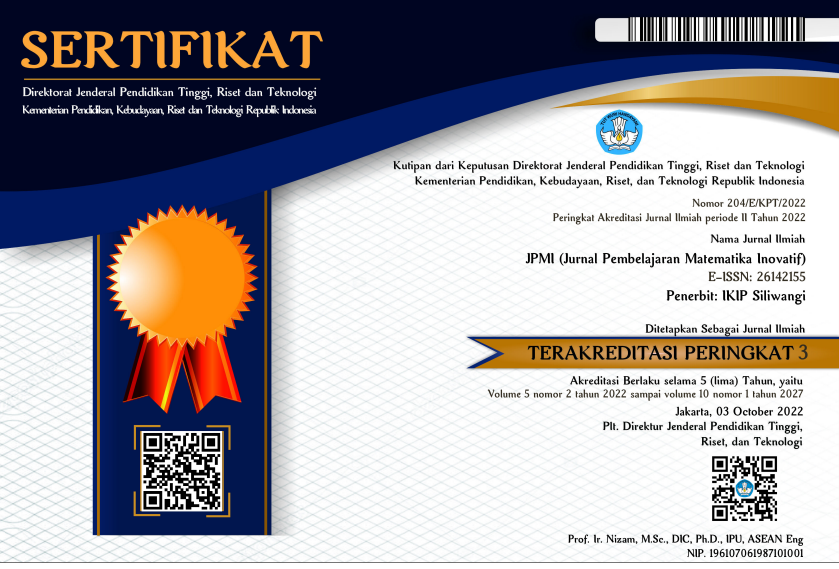LITERASI MATEMATIKA SISWA DALAM MEMECAHKAN MASALAH HOTS
DOI:
https://doi.org/10.22460/jpmi.v6i3.17581Keywords:
Mathematical Literacy, HOTS Problem, CirclesAbstract
References
Anderson, L. W., Krathwohl Peter W Airasian, D. R., Cruikshank, K. A., Mayer, R. E., Pintrich, P. R., Raths, J., & Wittrock, M. C. (2001). A taxonomy for learning, teaching, and assessing.
Dinni, H. N. (2018). HOTS (High Order Thinking Skills) dan kaitannya dengan kemampuan literasi matematika. PRISMA, PROSIDING SEMINAR NASIONAL MATEMATIKA, 170–176. https://journal.unnes.ac.id/sju/index.php/prisma/
Dosinaeng, W. B. N., Leton, S. I., & Lakapu, M. (2019). Kemampuan mahasiswa dalam menyelesaikan masalah matematis berorientasi HOTS. JNPM (Jurnal Nasional Pendidikan Matematika), 3(2), 250–264. https://doi.org/10.33603/jnpm.v3i2.2197
Erfan, M., & Ratu, T. (2018). Pencapaian HOTS (Higher Order Thinking Skills) mahasiswa program studi pendidikan fisika fkip universitas samawa. Jurnal Pendidikan Fisika Dan Teknologi, 4(2), 208–212. https://doi.org/10.29303/jpft.v4i2.831
Eric, C. C. M. (2009). Mathematical modelling as problem solving for children in the singapore mathematics classrooms. Mathematical Modelling Journal of Science and Mathematics Education in Southeast Asia, 32(1), 36–61.
Farida, N. (2015). Analisis kesalahan siswa smp kelas viii dalam menyelesaikan masalah soal cerita matematika. Aksioma: Jurnal Pendidikan Matematika FKIP Univ. Muhammadiyah Metro, 4(2), 42–52.
Fazzilah, E., Effendi, K. N. S., & Marlina, R. (2020). Analisis kesalahan siswa dalam menyelesaikan soal pisa konten uncertainty and data. Jurnal Cendekia: Jurnal Pendidikan Matematika, 04(02), 1034–1043.
Hasanah, U., Edwita, & Januar, A. (2019). Literasi matematika, gaya kognitif dengan high order thinking skill: studi korelasional pada siswa sekolah dasar. JPD: Jurnal Pendidikan Dasar, 11–23. https://doi.org/10.21009/JPD.0102.02
Hudiono, B. (2010). Peran pembelajaran diskursus multi representasi terhadap pengembangan kemampuan matematika dan daya representasi pada siswa SLTP. Jurnal Cakrawala Kependidikan, 8(2), 101–203.
Lestari, A. P., Hasbi, M., & Lefrida, R. (n.d.). Analisis kesalahan siswa kelas ix dalam menyelesaikan soal cerita keliling dan luas lingkaran di SMP AL-Azhar Palu.
Masyhuri, & Zainuddin. (2011). Metodologi penelitian pendekatan praktis dan aplikatif (N. F. Atif, Ed.; Edisi Revisi).
National Council of Teachers of Mathematics. (2000). Principles and standards for school mathematics. United States of America: The National Council of Teachers of Mathematics, Inc.
Nuridawani, Munzir, S., & Saiman. (2015). Peningkatan kemampuan penalaran matematis dan kemandirian belajar siswa madrasah tsanawiyah (MTs) melalui pendekatan contextual teaching and learning (CTL). Jurnal Didaktik Matematika, 2(2), 59–71.
OECD. (2019a). Chapter 3. PISA 2018 Mathematics Framework. www.oecd.org/pisa/
OECD. (2019b). The programme for international student assesment (PISA) Result From PISA 2018.
Ojose, B. (2011). Mathematics literacy: are we able to put the mathematics we learn into everyday use? Journal of Mathematics Education, 4(1), 89–100.
Prabawati, M. N. (2018). Analisis kemampuan literasi matematik mahasiswa calon guru matematika. Jurnal Mosharafa, 7(1), 113–120. http://e-mosharafa.org/index.php/mosharafa
Ratri, A. K., & Setyaningsih, N. (2020). Analisis literasi matematika terhadap kemampuan menyelesaikan soal berorientasi high order thinking skills. PROSIDING.
Ridzkiyah, N., & Effendi, K. N. S. (2021). Analisis kemampuan literasi matematis siswa sma dalam menyelesaikan soal program for international student assessment (PISA). Jurnal Ilmiah Pendidikan Matematika, 6(1), 1–13.
Sekerak, J. (2010). Phases of mathematical modelling and competence of high school students. Journal The Teaching of Mathematics, XIII(2), 105–112.
Sugiyono. (2014). Metode penelitian kuantitatif kualitatif dan R&D (cet. 21). Bandung: Alfabet.
Sumanto. (1995). Metodologi penelitian sosial dan pendidikan: aplikasi kuantitatif dan statistika dalam penelitian (Edisi 2). Andi Offset.
Tanujaya, B., Mumu, J., & Margono, G. (2017). The relationship between higher order thinking skills and academic performance of student in mathematics instruction. International Education Studies, 10(11), 78. https://doi.org/10.5539/ies.v10n11p78
Widana, W. (2017). Modul penyusunan soal higher order thinking skills (HOTS). Direktorat Pembinaan SMA Ditjen Pendidikan Dasar dan Menengah.
Zahroh, H., Hafidah, Dhofir, & Zayyadi, Moh. (2020). Gerakan literasi matematika dalam peningkatan kemampuan pemecahan masalah matematis siswa. Delta-Pi: Jurnal Matematika Dan Pendidikan Matematika, 9(2), 165–177

















